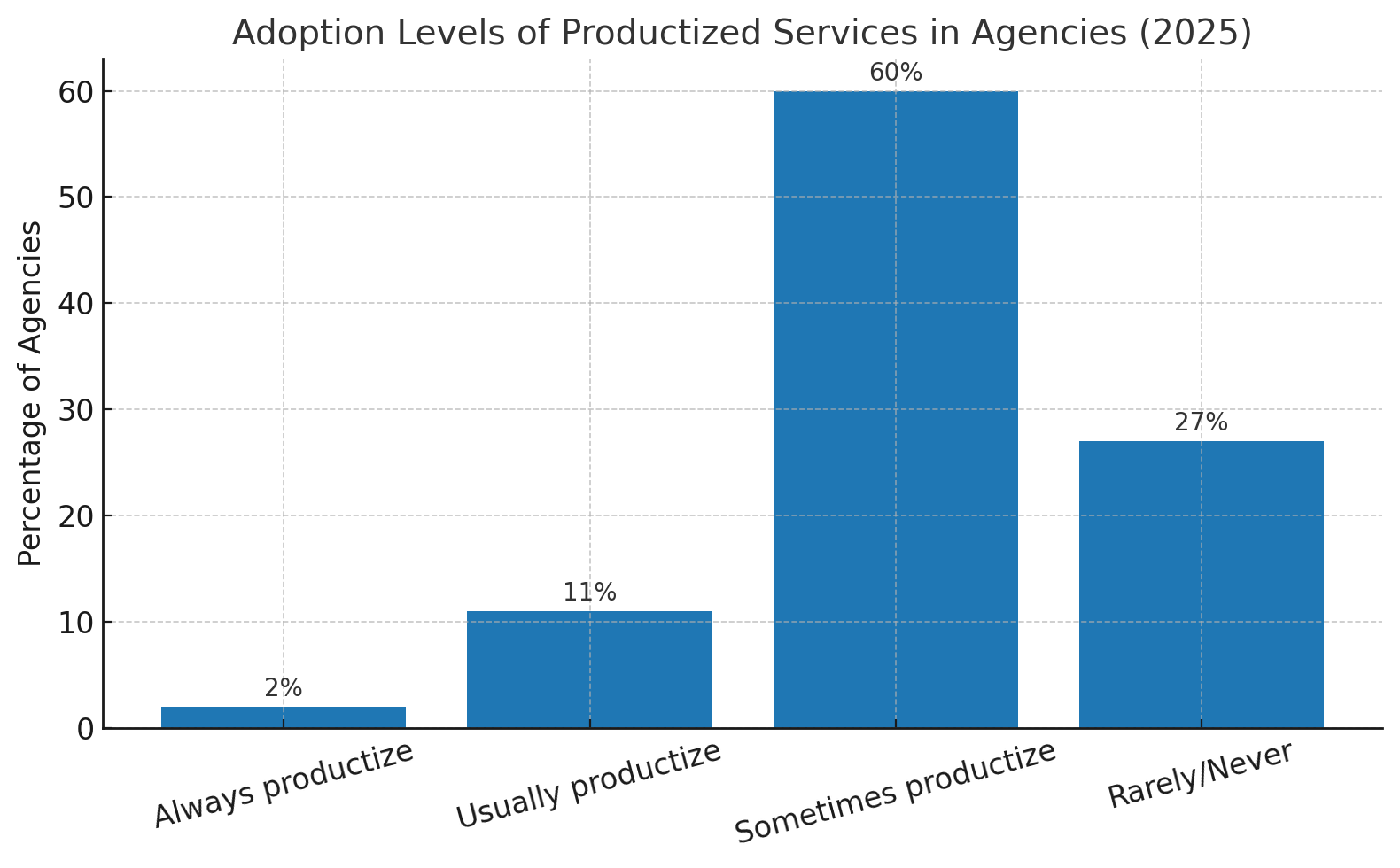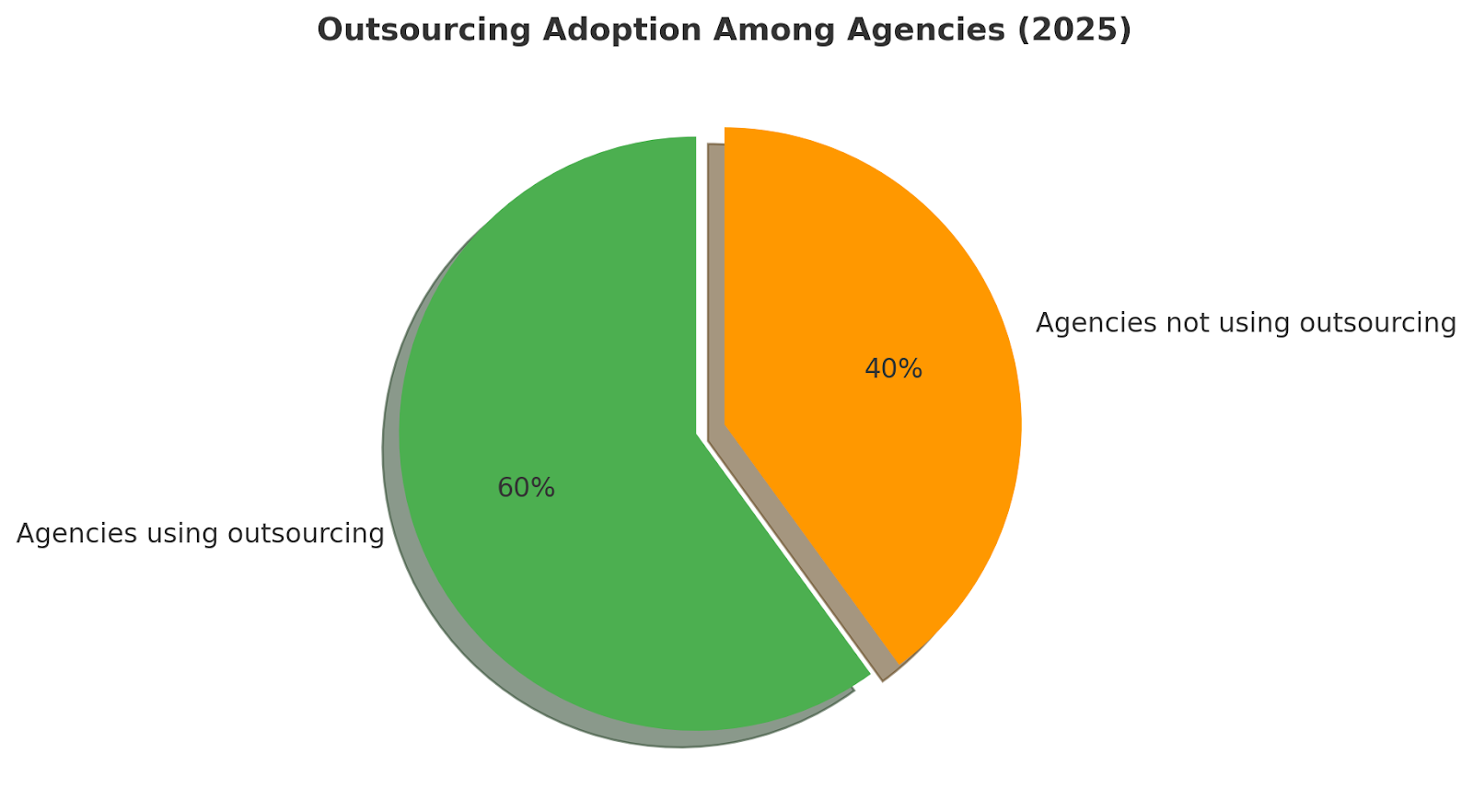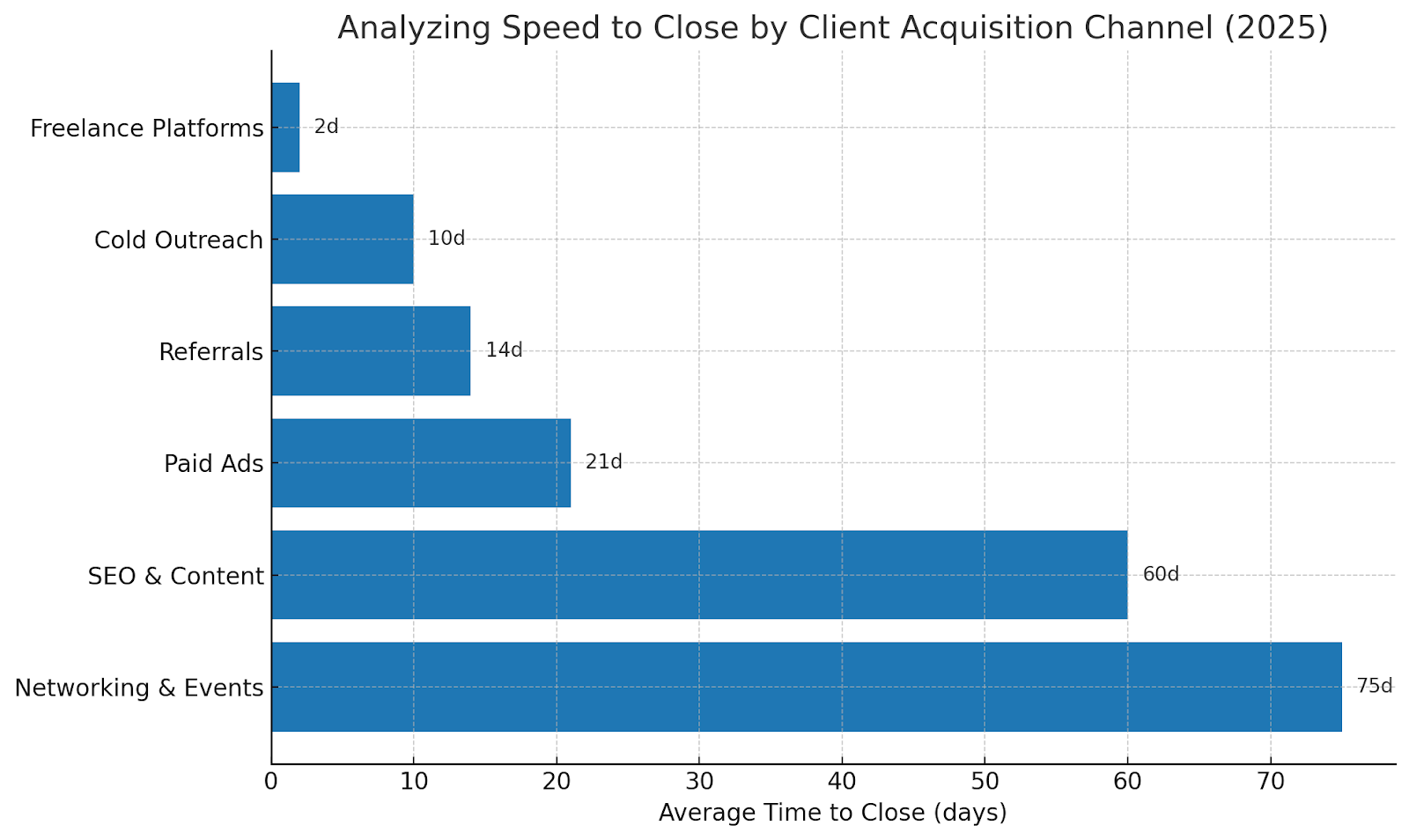Running a marketing agency today looks nothing like... it did even a few years ago. The channels have changed and the clients are pickier, while half the tools you relied on in 2022 either got replaced or became irrelevant. But the core question stays the same – how exactly do agencies earn, and where do the clients come from?
There’s no single formula. Some agencies survive on retainers, others chase short-term gigs or rev share deals. Some build audiences and monetize through content. Others stay invisible and make money through white-label work for bigger shops. The methods vary – but the goal is always the same: build something sustainable that doesn’t rely on luck or referrals alone.
In this breakdown, we’ll go through how agencies actually make money in 2025. We’ll also show what’s working (and what’s not) when it comes to getting new clients, especially in a world where everyone has a personal brand and a cold DM pitch.
Let’s start with how the business models really work.
Understanding Agency Revenue Models Matters in 2025
If you’re running a marketing agency in 2025, understanding how marketing agencies make money isn’t just a strategy thing – it’s survival.
The days of offering “full service” are gone. Clients expect specialization, fast results, and pricing models that align with performance. That means your revenue model can’t just be “whatever works.” It needs to be intentional.
With tighter client budgets, AI eating into service value, and global competition, agencies can’t just sell time anymore – they need to sell outcomes or systems.
Some agencies still stick to monthly retainers. Others prefer short sprints, commission-based deals, or even subscription-style billing. You’ll also see hybrids: a small retainer plus a performance bonus, or content packaged like a product. The most stable ones? They’re not guessing – they’ve mapped their income to the way clients want to pay.
And in 2025, that flexibility is key. Clients want clarity, predictability, and some upside. Agencies that match those expectations, while still protecting margins, are the ones that last.
Next, let’s break down the most common business models you’ll see this year, and what actually makes them work.
Core Business Models Behind Agency Income
Not all agency income is created equal. In 2025, how you charge matters just as much as what you offer. The model behind your services shapes not only your margins, but also who you attract and how long they stay.
A lot of people still search how do digital marketing agencies make money, and the truth is, there’s no single answer.
Let’s walk through the main structures agencies use to get paid – and where each one makes sense.
Retainer vs. Project-Based vs. Performance-Based
When people ask how do advertising agencies get paid, these are still the most recognizable models – but the way they’re used in 2025 looks a bit different. According to recent reports, around 91% of agencies still offer retainers, 60%+ rely heavily on project-based billing, while only about 5% experiment with pure performance-based deals.

Retainers work best for ongoing, strategic work: SEO, content, monthly reporting, and cross-channel coordination. But long-term deals are harder to lock without clear deliverables. Clients want transparency, not a vague promise of “support.”
Project-based billing suits well-defined scopes: a new brand identity, a landing page funnel, or a product launch campaign. But project churn burns teams out. It’s tough to grow on one-offs unless they feed into larger engagements.
Performance-based deals are gaining ground fast, especially for media buying and email. But they require airtight tracking, shared dashboards, and mutual trust. Attribution fights can kill even good campaigns if expectations weren’t set upfront. In 2025, more agencies are blending this model with a small base retainer to stabilize cash flow.
Subscription and SaaS-Based Models
Treating services like products isn’t new, but the infrastructure to deliver them properly has caught up.
Some agencies now bundle offers like a SaaS company: pay $2,500/month for 4 newsletters, 10 LinkedIn creatives, and two strategy calls. It’s predictable, scalable, and easier to sell on the website. In fact, reports show that only 2 % of agencies “always” sell productized services and 11 % “usually” do, while the majority “sometimes” productize, indicating growing but cautious adoption. With productized billing platforms and client dashboards, even small teams can now pull this off.

Others are going further and building actual software – white-label tools, client portals, analytics dashboards – and charging access fees alongside service retainers. These aren’t agencies turning into SaaS companies. They’re protecting margins and deepening client lock-in.
White Label and Outsourcing Revenue
Some agencies don’t just serve clients; they serve other agencies.
White label fulfillment lets you take on work without chasing leads. A design agency in Berlin might handle branding for a US-based growth shop under their name. More than 60 % of agencies already use outsourcing to scale services like PPC and digital campaigns.

And if you’re wondering how do creative agencies make money in such setups, the answer is simple: they trade visibility for predictability, sacrificing brand credit but gaining recurring, low-cost revenue. The money’s smaller, but predictable. And the sales cost is near zero.
Outsourcing revenue works similarly – whether you’re building landing pages for a dev house or ghostwriting for an SEO firm. You’re not the face of the deal, but you’re in the delivery stack.
Both models demand flawless operations. If you’re invisible to the client, your only value is reliability and speed.
Top Revenue Streams for Marketing Agencies
Structuring how you charge is one thing. But what actually brings in the money? That’s a separate conversation – and one that’s changing fast.
In 2025, agency revenue doesn’t just come from “services.” It comes from owning specific outcomes and knowing how to package them.
Below are the streams that consistently drive income for agencies.
Paid Advertising Campaigns
Paid media is still one of the most reliable answers to how do advertising agencies make money, but it’s not what it used to be. In 2025, agencies make money not just from managing ad spend, but from owning parts of the outcome. That could mean charging for performance (like per qualified lead), or bundling media planning, creative, and platform management into a fixed-cost sprint.
The highest-margin setups? They often include proprietary tools – audience scoring, ad testing frameworks, or even data partnerships. These let agencies charge not just for labor, but for the system behind it. It’s not “we run your ads” anymore. It’s “we know what converts, and we’ll plug you into it.”
SEO and Content Marketing Services
SEO is no longer sold as “we’ll rank you on Google.” In a world of shrinking SERP real estate and AI rewriting the discovery journey, agencies that still make real money here focus on three things:
• Owning niche verticals where AI summaries still reference top domains
• Creating content that ranks and captures (CTAs, gated tools, monetized assets)
• Structuring content like a product – with strategy, delivery, and iteration loops
Top agencies in 2025 productize their content work. That could mean offering a monthly “Topic Cluster Kit” or a long-form + repurposing system billed quarterly. Some even go revenue-share if the funnel is airtight. This is one of the clearest answers to how does a digital marketing agency make money in the current market. Either way, pure “blog writing” is dead. You’re selling owned attention and clients pay for that.
Social Media Management
Social media management remains one of the most stable revenue drivers for agencies, but because it’s persistent. Clients know they need to be on social. But most don’t have the time or internal expertise to do it well. And that’s where agencies step in, to maintain a consistent brand presence, drive engagement, and manage communities.
Now the value lies in retention, not reach. LinkedIn, TikTok, and such platforms prioritize authentic engagement over raw numbers – so agencies that build client strategies around comments, DMs, and micro-influencer interactions often see more solid contracts. Bundling this with content creation or paid social gives even more upsell potential.
This model explains a lot about how do digital marketing companies make money in 2025: monthly retainers for content calendars, posting, moderation, and reporting stack up predictably over time.
And it’s a similar story for how do influencer marketing agencies make money by curating authentic brand alignment, managing collaborations, and monetizing reach through structured campaign delivery.
Email Marketing Services
Email still converts – when it’s done right. That means owning the entire lifecycle: segmentation, automation flows, A/B testing, deliverability and integration with CRM systems. And yes, this is a perfect example of how do marketing companies make money by offering not just execution, but technical implementation, strategic planning, and ongoing optimization.
In 2025, clients are moving away from “blast everyone” campaigns and toward micro-targeted, behavior-based sequences. Agencies that offer strategy and execution – welcome flows, abandoned cart nudges, post-purchase funnels – often charge project fees plus monthly optimization retainers.
There’s also room to sell platform migration (e.g., Klaviyo to Customer.io) or analytics audits. These aren’t just one-off gigs; they often open doors to long-term marketing support.
Consulting and Strategy Sessions
Many clients are past the point of hiring random executors. They want guidance.
So how do marketing firms make money now? Agencies that position themselves as thinking partners, helping define messaging, funnels, or product-market fit, can charge premium hourly rates or fixed packages.
This model doesn’t require hands-on execution. It makes it scalable and less resource-intensive. And it often leads into broader implementation work once trust is built.
In 2025, strategy isn’t just about “what to post.” It’s often about integrating marketing across product, growth, and customer success. Agencies that speak the language of business goals win better retainers.
Training, Workshops, and Courses
Some clients don’t want a done-for-you solution – they want to build internal skills. Agencies can monetize their expertise by offering internal training for marketing teams, live workshops for founders, or even asynchronous courses in niche areas like B2B demand gen or UGC strategy.
This stream scales well with low overhead and high margins, especially if packaged smartly. Agencies can charge thousands for custom corporate training or set up evergreen courses to capture inbound leads and passive revenue.
By turning internal methods into teachable material, agencies also position themselves as authorities, which fuels demand for their consulting and execution work. And it’s a model that shows how do influencer agencies make money too, by productizing their methods into scalable education and advisory offers.
Of course, none of these revenue streams matter if you can’t keep new business coming in. The services might be great, but without consistent lead flow, the agency won’t grow. So how do the best agencies actually find and convert clients in 2025? Let’s break that down next.
How Agencies Attract and Convert Clients
Getting attention is one thing. Turning it into paid work is another. In 2025, clients are more skeptical, more distracted, and often more educated about marketing than ever before. They’ve seen the pitch decks. They’ve heard the promises. And they’ve probably been burned at least once.
So when agencies try to land clients, they can’t rely on flashy portfolios or casual DMs. They need a process – not just for reaching out, but for building trust and making the decision to buy feel obvious.

Let’s look at what’s still working – and what’s evolved.
Cold Outreach (Cold Email, LinkedIn)
Cold outreach isn’t dead, but lazy outreach is. If you’re still blasting generic “we help businesses grow” messages, you’re invisible.
The game in 2025 is precision over volume. Smart agencies are running outbound like inbound. That means:
• Warm-up via micro-engagements (likes, follows, quote replies)
• Contextual icebreakers (mentioning recent posts, hiring moves, or tech used)
• Custom landing pages per vertical
• Tracking opens/clicks + retargeting with custom LinkedIn audiences
The agency playbook is merging with sales ops. Agencies now use tools like Clay, Instantly, and Waalaxy – not just to send, but to learn what converts. And once a reply comes in, automation ends. Real people close deals.
Referrals and Word-of-Mouth
Still the highest-converting channel and still wildly underutilized.
But let’s be honest: hoping for referrals isn’t a strategy. In 2025, great agencies engineer referrals. That means:
• Building feedback loops into client workflows (automated “how are we doing?” surveys)
• Creating shareable win reports (“here’s what we did + outcome”)
• Offering referral bonuses not as bribes, but as thanks
• Featuring clients publicly: tagging them in case studies, interviews, or even memes
Most of all, they stay in touch after delivery. Because referrals don’t come from closed projects, they come from open relationships.
Personal Branding & Content Marketing
No founder can afford to be anonymous anymore. Whether it’s LinkedIn, X, or podcasts, clients want to see who’s behind the agency and whether they actually know their stuff.
So how do media agencies make money from all this visibility? Not by chasing vanity metrics, but by showing expertise where it counts.
In 2025, content marketing doesn’t mean weekly blog posts or repurposed threads. What’s working now:
• Original POVs on industry shifts, not regurgitated trends
• Short, visual breakdowns of real client problems (slide-style posts)
• Behind-the-scenes ops: how you run onboarding, team syncs, audits
• First-party data: sharing benchmarks from your niche (even anonymously)
Agencies that build audiences don’t just close faster, they get pre-qualified inbound. Clients reach out already believing you’re the right one.
SEO and Organic Website Traffic
Organic traffic isn’t just about writing blog posts anymore; that train left years ago. In 2025, agency SEO means building authority around very specific queries from your ICP. And that starts with owning your niche.
Instead of chasing generic keywords like “marketing agency for SaaS,” smart agencies rank for painkiller searches: “how to lower CAC in fintech” or “referral strategy that works for DTC in 2025.” It’s about search intent that leads to meetings.
Also, SEO now blends with digital PR. If you’re not landing backlinks from high-context sources – Substacks, podcasts, co-branded research – you’re invisible. Google is rewarding depth and reputation, not just technical hygiene.
Takeaway: SEO in 2025 is part research, part content, part distribution. And the ones who crack it get clients who already trust them before the first call.
Paid Ads (Google, Meta, YouTube)
If you’re wondering how does an ad agency make money in 2025, here’s the short answer: not by running generic lead gen campaigns that drain budgets without converting.
So how do ad agencies get paid today? Most work on a mix of flat fees, performance bonuses, and revenue share, but the real value comes from what happens after the click.
How do media agencies make money, then? By turning attention into trust and packaging that into low-friction, conversion-layer offers: audits, teardown videos, live scorecards. Stuff that feels like value, not a pitch.
And remember: ad fatigue is real. If you’re not testing creative in UGC-style formats, playing with vertical video, and retargeting with emotion-driven narratives, you’re behind. For agencies, showing how you work beats shouting what you offer.
Hint: Instead of “book a call,” test “watch how we helped X scale from 0 to 1M.” Top agencies turn paid traffic into case study traffic.
Networking and Events
In-person is back, but the ROI isn’t in the booth, it’s in the bar.
Agencies making the most out of events aren’t just attending talks. They’re booking side dinners, hosting AMAs, co-creating live content, and sending pre-event cold DMs to line up 10 meetings before day one. Think of it like a warm outbound campaign, but with handshakes.
And post-event? No one wants your “great to connect” follow-up. Stand out with tailored recaps, a Loom summarizing ideas you discussed, or a LinkedIn post tagging your new leads into the conversation.
Pro tip: Events don’t scale, but relationships do. That one DM or lunch might fill your pipeline for months.
Strategic Partnerships and White-Label Deals
Most agencies think white-label = low-margin grunt work. But in 2025, it’s your distribution hack.
Great agencies are embedding themselves as the “execution arm” inside productized services, platforms, or consultants who don’t want to build their own delivery teams. The key is packaging your offer so they look good while you get repeat work.
Example: You partner with a CRM platform to run onboarding campaigns for their clients. You get the volume. They look like they offer full-service support.
Tip: You don’t need 50 partners. You need 3 good ones with overlapping ICP and clear value alignment. That’s recurring revenue with zero CAC.
Freelance Platforms (Upwork, Fiverr, Toptal)
These platforms used to be a race to the bottom. Now? They’re filters for inbound.
In 2025, top agencies treat Upwork like a testing ground – short-term wins that build case studies, fill cash flow gaps, and sharpen positioning. The secret? Don’t look like everyone else.
Use hyper-niche titles. Respond with Looms. Link to real client outcomes, not proposals. And use every closed deal to start a “client flywheel” – one job becomes three if you nail it and upsell with confidence.
For proof – one Irish paid-ads agency leveraged Upwork smarter and, with help automating outreach, made about $6,500 in just 2–3 months and doubled its lead flow. Read the full case study here.
Also, if you’re optimizing your Upwork profile, adding a lean, results-focused portfolio can be a game-changer: use our guide see up to 5x more job wins. Here’s how to build one.
Smart play: once you have a working pattern – automate it. Build a system that turns leads into long-term retainers, while you focus on delivery or growth. That’s the real game: turning platforms into pipelines.
Scaling Your Marketing Agency for Sustainable Growth
Most agencies hit their first plateau not because of a lack of clients – but because they keep scaling the same way they started. More team members, more client calls, more tools glued together. It works, until it doesn’t.
In 2025, sustainable growth is about building systems that carry their own momentum. That starts with predictable inbound. Agencies are investing in assets that attract clients on autopilot: high-ranking SEO content, niche newsletters, lead magnets paired with email sequences, and branded micro-communities. The goal is simple – let people come to you already warmed up.
From there, growth compounds when you tighten the flywheel. Not just “more leads, more sales,” but stronger delivery, better outcomes, easier referrals, faster conversions. The agencies that scale well don’t just deliver work – they productize outcomes. They build signature frameworks, name them, and turn client success into a repeatable playbook. That playbook becomes your leverage.
Retention is also a multiplier most agencies underestimate. Keeping clients longer, upselling them smarter, and turning them into long-term partners doesn’t just increase LTV, it gives your team breathing room. That’s where AI enters the picture. Instead of replacing roles, AI in 2025 quietly reinforces them. It drafts proposals, handles reporting, summarizes calls, or helps junior team members level up faster. And when AI reduces delivery time without reducing quality, margins rise without the burnout.
Scaling today means building systems that don’t collapse when your calendar’s full. It means turning every new client into three future ones – and every task into a process that runs whether you’re in the office or off the grid.
But of course, that’s the ideal. In reality, agencies still run into the same friction points: pricing stalls, low close rates, bad-fit clients, churn. And that’s where we’re headed next.
Invisible Bottlenecks That Kill Agency Growth
Some agencies don’t hit a ceiling, they build it themselves.
It rarely happens overnight. Growth slows down, but you’re busy, so it feels like a temporary thing. Maybe your team is stretched too thin, or you’re stuck in endless client calls. Then a few months go by, and you’re still in the same spot, making decent money, but everything feels heavier than it should.
That’s usually not a client problem. It’s an internal bottleneck.
Most agencies hit one of three silent blockers and they tend to hide behind “being busy.”
The first is custom overload. The work is too tailored, too manual, and too tied to a specific client’s needs. Sounds good on paper, until you realize you can’t scale custom. You’ve essentially built a one-person factory for every deal. The team burns out. Profit margins shrink. Delivery time balloons.
The second is positioning gaps. You’re attracting clients, but they’re not the right ones. Maybe they negotiate too hard. Or they churn fast. Or they come in expecting performance guarantees without understanding your value. That usually means you’re either too broad, too cheap, or too quiet about what makes you different. And fixing that requires sharpening your niche, not shouting louder.
The third is sales inconsistency. It’s the space between projects that bleeds the most. When you’re heads-down in delivery, lead generation slows down. Then, once a project wraps up, there’s a scramble for the next one. That seesaw rhythm kills momentum. It also makes hiring risky, since you’re never sure when the next deal lands.
What makes these bottlenecks tricky is that they don’t look like failure. They look like “busy weeks,” “tough clients,” or “just a slow month.” But left unchecked, they drag down everything – team morale, growth potential, and profit.

The fix isn’t a new offer or a new funnel. It’s clarity. Knowing which part of your engine is slowing everything else down – and rebuilding just that.
In the next block, we’ll look at how some agencies not only avoid these traps but also maximize what’s already working – and why 2025 opens up new ways to grow without chasing trends or overworking your team.
Maximize Your Marketing Agency’s Revenue in 2025
More revenue isn’t just about taking on more clients. It’s about making more from the clients you already have without burning out your team or bloating your overhead. The agencies that grow fastest in 2025 aren’t just good at marketing. They’re good at structuring their offers, packaging their expertise, and building systems that multiply output without multiplying effort.
One of the most underrated levers is pricing structure. If you’re still quoting custom projects for every new client, you’re leaving money (and sanity) on the table. Productized services – like fixed-price SEO audits, strategy sprints, or ad account revamps – bring predictability to both revenue and delivery. You just get paid faster and also avoid endless scope creep.
Another growth lever: value stacking. Add complementary services clients actually need. Running ads? Include conversion audits. Doing content? Add a distribution checklist and quarterly performance call. Clients don’t always need more hours. They need more outcomes. When you package those outcomes right, you can charge more without doing more.
And finally, look at your backend. Manual reporting, onboarding, and client comms eat into your margin faster than you think. Every workflow that lives in Google Sheets and Slack DMs is a leaky pipe. The best agencies are tightening those leaks by using automation, especially on platforms where they already operate.
Which brings us to where most of that client work starts: Upwork. The right automations here directly impact how fast and reliably you win business.
How GigRadar Can Help Agencies Boost Your Client Acquisition
Most platforms treat agencies like freelancers with a logo. GigRadar doesn’t.
It’s not just a marketplace. It’s a pipeline builder designed for agencies that know how to close – but don’t always have time to chase.
On GigRadar, clients don’t browse hundreds of listings. Agencies get visibility only on leads that match their capacity and positioning, not random one-off jobs.
Instead of pitching from scratch, you’re entering qualified conversations. That’s a huge shift.
Add to that: lead scoring, built-in client comms, visibility analytics, and positioning tools designed for teams, not solo contractors. GigRadar isn’t just helping you find clients. It’s removing the friction between you and your next deal.




.webp)
.webp)
.webp)
